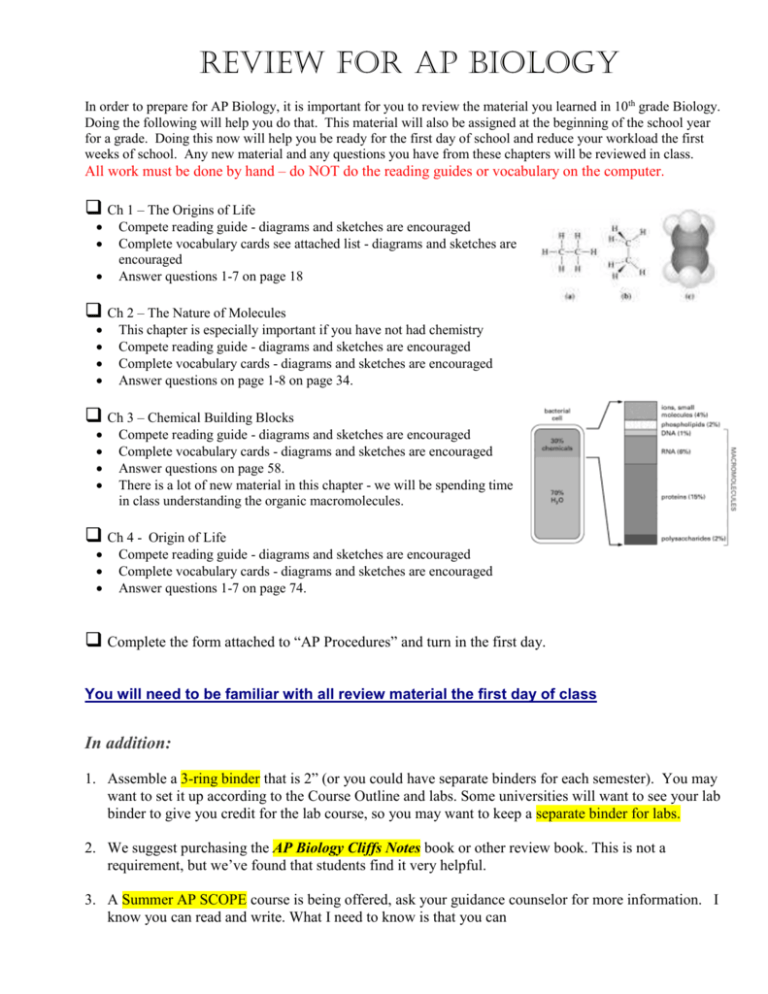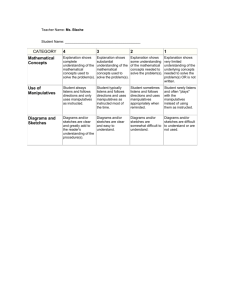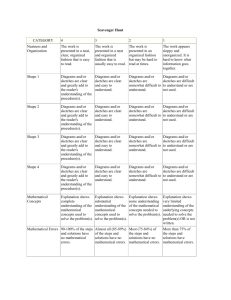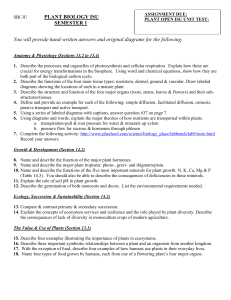In addition
advertisement

REVIEW FOR AP BIOLOGY In order to prepare for AP Biology, it is important for you to review the material you learned in 10th grade Biology. Doing the following will help you do that. This material will also be assigned at the beginning of the school year for a grade. Doing this now will help you be ready for the first day of school and reduce your workload the first weeks of school. Any new material and any questions you have from these chapters will be reviewed in class. All work must be done by hand – do NOT do the reading guides or vocabulary on the computer. Ch 1 – The Origins of Life Compete reading guide - diagrams and sketches are encouraged Complete vocabulary cards see attached list - diagrams and sketches are encouraged Answer questions 1-7 on page 18 Ch 2 – The Nature of Molecules This chapter is especially important if you have not had chemistry Compete reading guide - diagrams and sketches are encouraged Complete vocabulary cards - diagrams and sketches are encouraged Answer questions on page 1-8 on page 34. Ch 3 – Chemical Building Blocks Compete reading guide - diagrams and sketches are encouraged Complete vocabulary cards - diagrams and sketches are encouraged Answer questions on page 58. There is a lot of new material in this chapter - we will be spending time in class understanding the organic macromolecules. Ch 4 Origin of Life Compete reading guide - diagrams and sketches are encouraged Complete vocabulary cards - diagrams and sketches are encouraged Answer questions 1-7 on page 74. Complete the form attached to “AP Procedures” and turn in the first day. You will need to be familiar with all review material the first day of class In addition: 1. Assemble a 3-ring binder that is 2” (or you could have separate binders for each semester). You may want to set it up according to the Course Outline and labs. Some universities will want to see your lab binder to give you credit for the lab course, so you may want to keep a separate binder for labs. 2. We suggest purchasing the AP Biology Cliffs Notes book or other review book. This is not a requirement, but we’ve found that students find it very helpful. 3. A Summer AP SCOPE course is being offered, ask your guidance counselor for more information. I know you can read and write. What I need to know is that you can Summer Vocabulary Make flash cards for the following words with the word on one side and the definition on the back. DO NOT copy from the text book or other source. Put the definitions in your own words to receive credit! I need to know you understand the meaning of the term, not that you can copy out of a book. Diagrams help most people learn and are encouraged! Ch. 1 1. 2. 3. 4. Ch. 2 1. 2. 3. 4. 5. 6. 7. 8. 9. 10. 11. 12. 13. 14. 15. 16. 17. Ch. 3 1. 2. 3. 4. 5. 6. inductive reasoning deductive reasoning homologous analogous 7. 8. 9. 10. 11. 12. atomic number, atomic mass isotope half-life cation, anion oxidation/reduction octet rule (rule of eight) ionic bond covalent bond polar hydrogen bonds specific heat hydration shell cohesion adhesion properties of water hydrophilic, hydrophobic buffer dehydration synthesis/hydrolysis peptide bond polypeptide motif domain primary, second, and quaternary structure of proteins 13. 14. 15. 16. 17. 18. 19. 20. 21. 22. Ch. 4 1. 2. 3. 4. 5. 6. 7. 8. 9. 10. 11. 12. chaperonins denaturation dissociation nucleotide (include a diagram of the structure) complementary ATP (include structure and show where energy is stored) phospholipid triacylglycerol terpene steroid monoaccharide (include examples) diaccharide (include examples) isomer glycogen cellulose chitin homeostasis Miller-Urey experiment primary abiogenesis coacervate prokaryote eukaryote archaebacteria methanogen anaerobic halophile, thermophile eubacteria endosymbiotic theory






